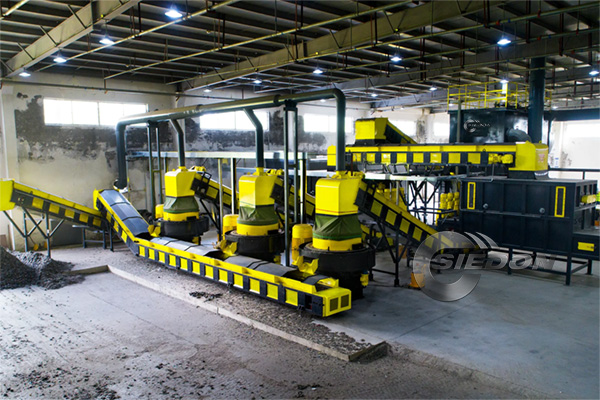Due to the large amount of domestic waste discharged and the complex and diverse components, it brings difficulties to the treatment and utilization. If it cannot be disposed of in time or improperly disposed, it will pollute the environment and affect the environmental sanitation. Garbage disposal is to remove the garbage quickly, treat it harmlessly, and then use it rationally. This paper introduces a Refuse-derived fuel (RDF shredder) clean combustion technology to achieve the goals of harmlessness, reduction and resource utilization of municipal solid waste.
1. Preparation and characteristics of RDF fuel
The Refuse-derived fuel (RDF) processing and production technology is to first crush the domestic waste, sort out combustibles, add additives to dry, and then extrude it to make granular RDF fuel. The characteristics of RDF fuel are uniform size and uniform calorific value. The molding process can increase the calorific value of garbage by about 4 times, and it is easy to transport and store. It will not spoil for 6 to 10 months when stored at room temperature. Therefore, a part of the garbage can be temporarily stored to solve the problem of disposal capacity during boiler shutdown or peak garbage output. In addition, by adding additives in the molding process, the purpose of removing SO2, HCl and reducing the emission of dioxins in the furnace can be achieved.
2. Application of Refuse-derived fuel
RDF can be used in garbage power plants, general thermal power plants (coal-fired) and general coal-fired mechanical boilers, and it will be more efficient to use on large boilers. Due to the limited amount of waste output in small and medium-sized cities, cities below the prefecture-level use waste zoning to process RDF, and then concentrate power generation in central cities, which can achieve good comprehensive benefits. For the same quality of waste, the application of RDF technology can double the power generation.

3. Comparison of RDF combustion technology and primary waste incineration technology
(1) The preparation of refuse-derived fuel RDF is not limited by site and scale, and is suitable for medium and small waste treatment plants for power generation. RDF combustion technology increases the power generation efficiency by 25% to 35% compared with the use of raw waste incineration, which is conducive to improving the scale and efficiency of waste power generation and making large-scale thermal energy recycling possible. Traditional waste incineration is limited by site and scale. When the amount of waste incinerated is less than 400t, it is generally used for hot water or steam. However, due to geographical conditions, seasonal changes and the surrounding environment, thermal energy is often not fully utilized.
(2) After sorting, dechlorination and desulfurization, the Refuse-derived fuel RDF can greatly reduce the corrosion of flue gas to equipment, and the flue gas and ash are reduced by 2/3 compared with the original waste incineration, which reduces the investment in related treatment equipment.
(3) Since RDF has good corrosion resistance, it can be stored for a long time and can be used as a reserve energy on demand. However, the direct incineration of primary waste will be affected by fluctuations in the composition of the waste, resulting in unstable thermal energy. Moreover, since the waste needs to be continuously consumed, the thermal energy must also be generated when there is no demand, resulting in wasted energy.
4. RDF Shredding Process
RDF calorific value is mainly through the processes of coarse crushing, sorting, fine crushing, and then processing into products. The most important and key processes are coarse crushing and fine crushing, which requires the use of suitable RDF solid waste crushers. Siedon Technology takes advantage of its own crushing technology to carry out research and targeted opening in the field of RDF, which greatly simplifies the RDF processing process and maximizes economic and ecological value.

5. RDF Shredder System
Various shredder machines are involved in RDF preparation technology. The function of the shredder, which type of shredder is required for each link, and the crushing effect required by each step are the top priorities for crusher selection.
The first shredder: coarse crushing of domestic waste. Crushed material <400mm.
After the primary domestic waste is roughly crushed, the size is less than 400mm, and it can enter the waste treatment system.
The second shredder: secondary crushing of domestic waste. Crushed material <150mm.
The particle size of the secondary coarsely crushed waste is less than 150 mm: this size of debris is suitable for use in grate combustion power plants, waste incineration power plants and cogeneration power plants with mechanical biological treatment. The calorific value of unsorted primary domestic waste is approximately 9-11 MJ per kilogram.
The third shredder: three-stage crushing of domestic waste. Crushed material <80mm.
After rough crushing and sorting of domestic waste, we can obtain the high calorific value part of the waste – waste-derived fuel (RDF). The RDF goes to the fine crusher, which yields <80mm pieces. Such scraps are suitable for co-processing in cement kilns, fluidized bed combustion and energy recovery power plants with a calorific value of approximately 15-18 MJ.
Fourth shredder: four-stage crushing of domestic waste. <30mm after crushing
Finely crushed waste-derived fuel < 30 mm (SRF): this small particle size is easily pumped into rotary kilns in cement plants and incinerators in waste incineration power plants; Secondary blend fuels have a heating value of at least 18-22 MJ.
